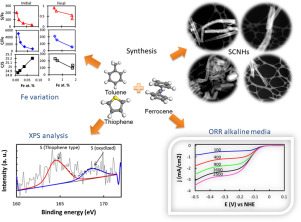当前位置:
X-MOL 学术
›
Diam. Relat. Mater.
›
论文详情
Our official English website, www.x-mol.net, welcomes your
feedback! (Note: you will need to create a separate account there.)
Sulfur doped carbon nanohorns towards oxygen reduction reaction
Diamond and Related Materials ( IF 4.3 ) Pub Date : 2020-03-01 , DOI: 10.1016/j.diamond.2019.107671 Elizabeth Montiel Macias , Ana M. Valenzuela-Muñiz , Gabriel Alonso-Núñez , Mario H. Farías Sánchez , Raynald Gauvin , Ysmael Verde Gómez
Diamond and Related Materials ( IF 4.3 ) Pub Date : 2020-03-01 , DOI: 10.1016/j.diamond.2019.107671 Elizabeth Montiel Macias , Ana M. Valenzuela-Muñiz , Gabriel Alonso-Núñez , Mario H. Farías Sánchez , Raynald Gauvin , Ysmael Verde Gómez

|
Abstract Platinum has been proved to be the most effective electrocatalyst for oxygen reduction reaction (ORR) in proton-exchange membrane (PEM) fuel cells; however, it presents some disadvantages such as its scarcity and, consequently, high cost. Recently, the development of electrocatalysts has been directed towards designing low Pt or Pt free materials. Carbon nanomaterials have shown good performance when used as Pt catalyst supports. Moreover, by modifying the properties, carbonaceous materials can be used also as catalysts. An alternative to change the carbon nanomaterial properties is their modification with heteroatoms. In the present work sulfur-doped carbon nanohorns (SCNHs) were synthesized by a modified chemical vapor deposition method (mCVD). Toluene and thiophene were used as respective carbon and carbon‑sulfur sources and ferrocene as catalytic agent. Iron amount was evaluated to determine the optimal synthesis conditions and influence in its properties. Physical and chemical characterization were performed by means of X-ray diffraction, scanning electron microscopy, Raman spectroscopy and high resolution scanning and transmission electron microscopy, energy dispersive spectroscopy and X-ray photoelectron spectroscopy. Additionally, the behavior of the obtained materials towards the ORR was studied by linear sweep voltammetry. Tubular structures with conical and horn-like shapes were obtained where sulfur and carbon formed thiophene type bonds. According to iron amount variation results, reducing Fe concentration improves morphological properties and maintains structural characteristics. Electrochemical results show acceptable activity for ORR, hence SCNHs can be considerate as non-Pt electrocatalyst for fuel cell electrodes. Prime novelty statement The originality reported in the manuscript is the synthesis of novel sulfur-doped carbon nanohorns with appropriate physical and chemical properties towards electrochemical energy devices applications.
中文翻译:

硫掺杂碳纳米角对氧还原反应
摘要 铂已被证明是质子交换膜(PEM)燃料电池中氧还原反应(ORR)最有效的电催化剂;然而,它存在一些缺点,例如其稀缺性,因此成本高。最近,电催化剂的开发已针对设计低 Pt 或无 Pt 材料。碳纳米材料在用作铂催化剂载体时表现出良好的性能。此外,通过改变性能,碳质材料也可以用作催化剂。改变碳纳米材料特性的另一种方法是用杂原子对其进行修饰。在目前的工作中,通过改进的化学气相沉积法 (mCVD) 合成了掺硫碳纳米角 (SCNH)。甲苯和噻吩分别作为碳源和碳硫源,二茂铁作为催化剂。评估铁量以确定最佳合成条件及其对性能的影响。通过X射线衍射、扫描电子显微镜、拉曼光谱和高分辨率扫描和透射电子显微镜、能量色散光谱和X射线光电子能谱进行物理和化学表征。此外,通过线性扫描伏安法研究了所得材料对 ORR 的行为。获得了具有锥形和角状形状的管状结构,其中硫和碳形成了噻吩型键。根据铁量变化结果,降低 Fe 浓度可改善形态特性并保持结构特征。电化学结果表明 ORR 具有可接受的活性,因此 SCNHs 可以考虑作为燃料电池电极的非 Pt 电催化剂。主要新颖性声明手稿中报道的原创性是合成新型掺硫碳纳米角,具有适当的物理和化学特性,可用于电化学能源设备应用。
更新日期:2020-03-01
中文翻译:

硫掺杂碳纳米角对氧还原反应
摘要 铂已被证明是质子交换膜(PEM)燃料电池中氧还原反应(ORR)最有效的电催化剂;然而,它存在一些缺点,例如其稀缺性,因此成本高。最近,电催化剂的开发已针对设计低 Pt 或无 Pt 材料。碳纳米材料在用作铂催化剂载体时表现出良好的性能。此外,通过改变性能,碳质材料也可以用作催化剂。改变碳纳米材料特性的另一种方法是用杂原子对其进行修饰。在目前的工作中,通过改进的化学气相沉积法 (mCVD) 合成了掺硫碳纳米角 (SCNH)。甲苯和噻吩分别作为碳源和碳硫源,二茂铁作为催化剂。评估铁量以确定最佳合成条件及其对性能的影响。通过X射线衍射、扫描电子显微镜、拉曼光谱和高分辨率扫描和透射电子显微镜、能量色散光谱和X射线光电子能谱进行物理和化学表征。此外,通过线性扫描伏安法研究了所得材料对 ORR 的行为。获得了具有锥形和角状形状的管状结构,其中硫和碳形成了噻吩型键。根据铁量变化结果,降低 Fe 浓度可改善形态特性并保持结构特征。电化学结果表明 ORR 具有可接受的活性,因此 SCNHs 可以考虑作为燃料电池电极的非 Pt 电催化剂。主要新颖性声明手稿中报道的原创性是合成新型掺硫碳纳米角,具有适当的物理和化学特性,可用于电化学能源设备应用。











































 京公网安备 11010802027423号
京公网安备 11010802027423号